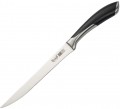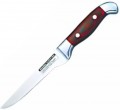Steel grade
The name of the steel grade from which the knife blade is made.
Its working properties directly depend on the type of steel — hardness, brittleness, tendency to corrosion, ability to keep sharpening, etc. Accordingly, this parameter largely determines the features of the knife as a whole. Many different grades of steel are used in modern kitchen knives; knowing the name of a particular brand, you can find detailed information about it (physical characteristics, reviews, user reviews) and evaluate the quality and overall level of the tool.
Handle material
— Plastic. Plastic is often considered a cheap and low-quality material, but this is not entirely true for kitchen knives. The fact is that the term "plastic" in this case can mean various types of polymers, often with very advanced specifications. Most often, the quality of the plastic handle directly depends on the price category of the knife. With all this, the
plastic handles are strong enough to use the knife for its intended purpose for at least several months, are easy to clean, and are also resistant to water and kitchen chemicals.
— Wood. The wood is pleasing to the eye and touch, can withstand hits and falls without any problems, and its durable varieties are not necessarily expensive. At the same time, this material is sensitive to water — it “absorbs” water, loses its presentation, resistance to cracks, chips and scratches (which is not very high anyway) and can even “bloom”, which is generally unacceptable for a kitchen appliance.
Wooden handles are not used too widely — either in the cheapest knives, where durability is not important, or vice versa, in premium-class models, where wood plays the role of an stylish material.
— Steel. This material is considered one of the most hygienic: it is easy to clean, and the design of the knife has virtually no gaps in which dirt can accumulate. In addition,
steel handles look very solid, durable and
...hard, withstand hits and falls without any problems, and are also scratch resistant. On the other hand, a steel handle is more likely to slip out of your hand than a wooden or plastic one.
— Steel with an insert. A variant designed to eliminate the main disadvantage of all-steel handles (see above) — an increased likelihood of slipping. This is what inserts are used for: they are made of rubber, plastic or other similar material that increases the "grip" of the palm with the knife handle. The presence of inserts is the only difference between handles of this type and all-steel; the rest of the features are completely identical.
— Silicone. A material that looks and feels similar to the plastic described above, but has its own specifics. The main practical difference is that silicone is much softer, some of its varieties are similar to rubber. This provides a more comfortable and secure hold in the hands; in addition, the silicone surface is often made slightly rough, which improves grip and further reduces the likelihood of slipping. On the other hand, this material is more expensive than plastic, and the advantages described are not decisive; therefore, silicone handles are not common, mainly among premium knives (although there are exceptions).Blade length
The length of a blade is usually measured from the point to the neck (the bulge between the blade and the handle). The value of this parameter is determined primarily by the type of knife. For example, in
models for cleaning, it rarely exceeds 12 cm — otherwise it would be inconvenient to work with small round products). Among
bread, on the contrary, blades shorter than 20 cm are rarely found — loaves of bread can be quite thick, which requires an appropriate knife, etc. However, knives of the same type can also vary significantly in length. In most cases, you can use this principle: a longer knife allows you to work with larger pieces of food, but it is less “agile”, and the length of the blade can affect the price.
Blade thickness
The thickness of the knife blade at its thickest point (usually at the butt). According to this parameter, one can to some extent evaluate the strength of the blade for transverse loads: a large thickness gives an appropriate margin of safety. At the same time, one should not forget that the “endurance” of a knife as a whole depends on many other features of its design, and only blades made of materials similar in properties can be compared in thickness. But what this indicator directly affects is the weight of the product.
Full tang (increased strength)
Knives for operations and work, in which there are increased loads on the blade and handle. The shank of the blade in their design continues until the end of the handle, usually it has the same thickness as the blade. The handle itself usually consists of two pads, planted on rivets or hidden pins. But there are other versions: with a solid metal or cast polymer handle. In such cases
Full tang knives can be identified by several distinguishing features – a protruding shank at the end, a lanyard hole through which a metal shank is visible, etc.

